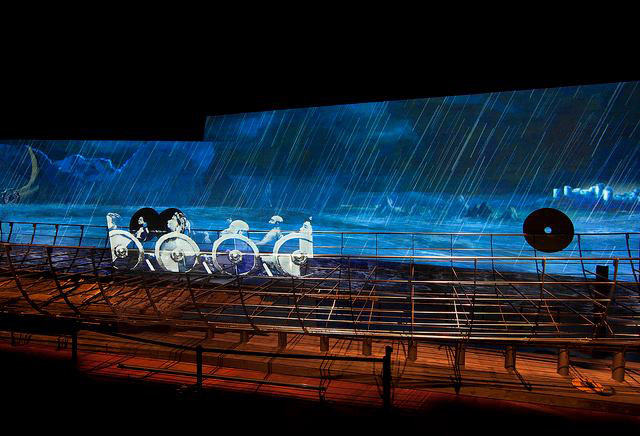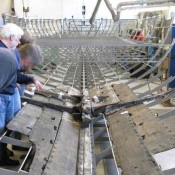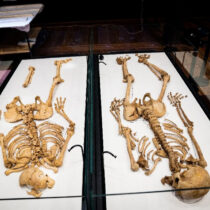Attempts to present the Vikings as mild-mannered traders and farmers are going to be smashed through a new exhibition of the longest Viking warship ever found, alongside swords and battle axes, many bearing the scars of long and bloody use.
“Some of my colleagues thought surely one sword is enough,” archaeologist and co-curator Anne Pedersen said, “but I said no, one can never have too many swords.”
The exhibition, simply called Viking, which will be opened at the National Museum in Copenhagen by Queen Margrethe of Denmark on Thursday, and to the public on Saturday, will sail on to to London next year to launch the British Museum’s new exhibition space.
This is the largest Viking exhibition in more than 20 years, bringing together loans from across Europe, including hoards from Yorkshire, Norway and Russia, a silver cross and a diminutive figure of a Valkyrie, a mythological battlefield figure, both found in Denmark only a few months ago. Loans from Britain include some of the famous Lewis chessmen carved as fierce Viking warriors, biting on the edge of their shields in an ecstasy of rage.
Some of the objects assembled from collections in 12 countries, such as a heap of walnut-sized pieces of amber, or jewellery made to incorporate Islamic and Byzantine coins, probably did come through trade. Others, such as a pair of brooches from the grave of a Viking woman made from gold intricately twisted into tiny animals, originally panels chopped up from a shrine made in Ireland to hold the relics of a saint, certainly were not.
One magnificent silver collar found in Norway has an inscription in runes saying the Vikings came to Frisia and “exchanged war garments with them” – but that may be a black joke. Iron slave collars from Dublin confirm that the wealth they sought wasn’t always gold and silver.
The most spectacular object, fitting into the gallery with just 1.7 metres (5ft6in) to spare – the new space in Bloomsbury has already been measured carefully – is the sleek, narrow hull of the longest Viking warship ever found, specially conserved for the exhibition and on display for the first time. Just over 36m in length, it was built to hold at least 100 men on 39 pairs of oars.
The ship was found by accident at Roskilde, home of the famous Viking ship museum. The museum was built 50 years ago to hold a small fleet of Viking boats that were deliberately sunk 1,000 years ago to narrow and protect the approach to the harbour. In the 1990s, workers building an extension chopped through the massive timbers of what turned out to be nine more ships, including the awesome length of the warship, estimated to have taken around 30,000 hours of skilled labour to build: only a king could have afforded such a vessel. Recent scientific tests show it was built from oak felled in 1025 near Oslo, probably for King Cnut the Great – the sea-defying Canute to the English – who conquered England in 1016, and Norway in 1028. Only a quarter of the timbers survived, but they included the entire length of the keel.
Discarding the politically correct Vikings’ image promoted by recent exhibitions, this returns to the more traditional image of ferocious raiders, spreading terror wherever the shallow keels of the best and fastest ships in Europe could reach, armed with magnificent swords, spears, battleaxes and lozenge-shaped arrows. “The arrow shape did more damage,” Pedersen explained, “the wounds were bigger and more difficult to heal than a straight-edged slit.”
Other powers employed the fearless warriors as mercenaries, including Byzantium and Jerusalem, but some were anxious to keep weapons of mass destruction out of their hands: a Frankish law forbade selling swords to Vikings. They got them anyway, as the exhibits prove.
A skull from a grave in Gotland bears the marks of many healed sword cuts, but also decorative parallel lines filed into the warrior’s teeth, like those recently found on teeth from a pit of decapitated bodies in Dorset, in what must have been an excruciating display of macho bravado.
“Probably only a small percentage of the Vikings ever went to sea on raiding parties, but I think those who stayed home would have told stories of great warriors, great ships and great swords they had known,” Pedersen said. “It was very much part of the culture.”
Although the exhibition includes sections on Viking politics, strategic alliances through marriage and trade, and beliefs including the contents of the grave of a sorceress with her iron magic wand and little pots of narcotic drugs, the warlike tone was dictated by the ship, which was itself a weapon of war. Vikings sang about ships – one refers to a new ship as “a dragon” – played as children with toy ships and, if rich enough, were eventually buried in ships.
The displays and some of the contents will change in London, but in Copenhagen the ship is spectacularly displayed against an animated backdrop of stormy seas and a ferocious raid that leaves the target settlement in flames.
The animation was made in the United States and the Danish team was initially dismayed as it appeared to show raiders attacking a much later medieval walled town. Eventually, curator Peter Pentz said, a Hampshire site saved the film: they agreed it was plausible that the towers and curtain walls could represent the ruins of a Roman shoreline fort, such as Portchester castle near Portsmouth.
As well as the swords, some bent like a folded belt to destroy their earthly use as they went into a warrior’s grave, there is one unique weapon, a battleaxe with an intricately decorated golden shaft. Such golden axes are described in the sagas, but this, from a settlement in Norway, is the only real example ever found.
“I think the main point was to impress, not to kill somebody,” Pedersen said, adding with satisfaction: “but you can kill somebody with it if you want.





